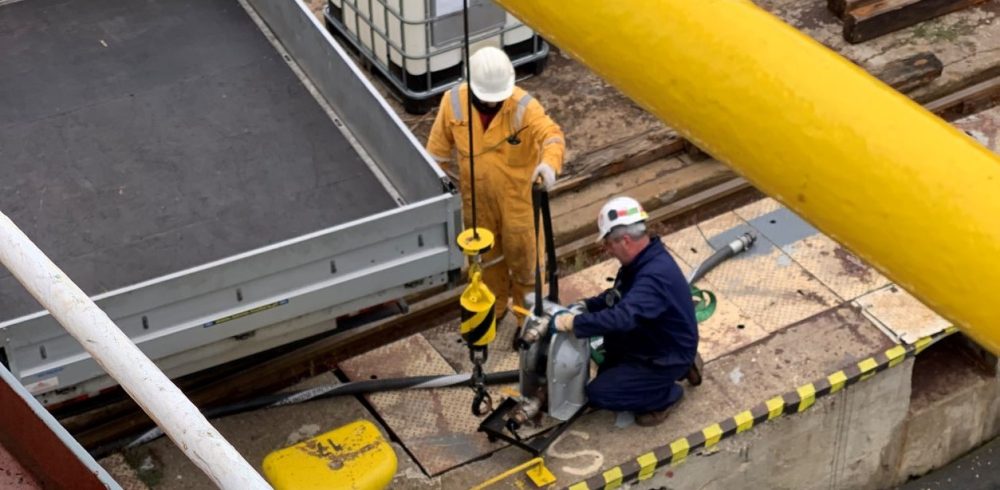When a customer in the marine industry realised that they had not been effectively monitoring their heat transfer system and fluid they contacted thermal fluid experts Global Heat Transfer, for support. After sampling the fluid and determining the extent of degradation, experts at Global Heat Transfer worked with the customer to find the most effective solution. Reducing the carbon levels in the system was not a simple task, but the final results provided the customer with a reliable and efficient heat transfer system.
Background
Thermal fluids can be used for a diverse range of applications in the marine industry, from maintaining the temperature of heavy fuel oils and heating liquid cargo to providing a variety of heating services in the engine room and accommodation areas. The customer contacted Global Heat Transfer, to take a sample of its thermal fluid from a large tanker.
Heat transfer fluids operate at high temperatures for long periods of time, and naturally degrade over time. If engineers do not regularly test the thermal fluid and get the specialist support and advice needed, they will not understand its condition. Degradation, caused by oxidation, causes sludge which is a thickening of the fluid which will block system pipes. To better understand its condition the marine customer sent a representative sample of the vessel’s thermal fluid for analysis.
Unreadable carbon levels
The initial analysis of the thermal oil sample was very concerning because the carbon percentage weight level was so high it was unreadable. Before this point, the previous highest recorded level for over 30 years was eight per cent weight of the fluid. It is important to note that one per cent weight of the fluid is the typical action point for changing out a fluid.
Due to the severe level of degradation, the lab couldn’t perform any of the eleven tests normally used to determine oil condition. As a result, fluid experts determined that the pumps, drains and strainers in the system were blocked with carbon debris. The system was covered with irremovable hard baked carbon fouling, which acts as an insulator, reducing heat transfer efficiency and causing hot spots on coils. The high levels of acidity in the system, caused by oxidation, was corrosive to the internal components of the system and drastically increased the risk of leaks and health and safety risks as pipe corroded.
If fluid condition continues to deteriorate and the system is not regularly maintained, the fluid can increase the risk of fire. Under the Dangerous Substances & Explosive Atmospheres Regulations (DSEAR) and the Explosive Atmosphere Directive (ATEX) regulations and health and safety laws, businesses must take steps to protect workers against risks from fire, explosion and similar events arising from dangerous substances present in the workplace, such as thermal fluids.
It was noted that some parts of the system were not heating up, indicating that the system was blocked. Given the fluid condition, it was also noted that when a hot sample was collected, the fluid solidified as it cooled. Due to this the system could not be switched off as the system would completely fail.
Once the marine customer understood the severity of its fluid issues, it looked for support to ensure oil condition met acceptable parameters and had a consistent flow, ensuring the vessel and crew could operate efficiently and safely onboard.
Flushing and refilling the system
Global Heat Transfer consulted with the marine customer and carried out multiple system flushes over several days to remove the degraded product. Due to the level of carbon fouling in the system, the risk of coils, pipework and components seizing if the fluid was cooled was too high. Instead, Global Heat Transfer engineers flushed the system at its regular operating temperature, and carefully managed the additional risks of working with a hot fluid.
Global Heat Transfer initially used cleaning and flushing fluid Globaltherm C1, which is specially formulated to remove any harsh by-products of organic and most synthetic thermal fluids. This product cleans and flushes as it passes through the system. The system was then refilled with fresh Globaltherm M oil, which operates up to 320 degrees C for extended periods.
Regular testing is key
After the whole system was cleaned and refilled, Global Heat Transfer took a sample that showed first viscosity levels were at 36.6 @40 degrees C mm2/s (est), compared to the first measurable level of 142. A typical system would expect a score of 32 for a mineral oil, like Globaltherm M oil, so considering the state of the system originally, this was a positive result.
The health and safety risks associated with the fluid drastically reduced. Flow was improved inside the system, reducing the risk of failure and burst pipes that could harm workers on the vessel and improving efficiency. The artificially low flash point of the fluid returned to a measurable and acceptable limit, significantly reducing the risk of fire.
To avoid issues like this in the future, the marine customer now routinely draws a live, hot circulating representative sample at operating temperature. The sample is then tested and analysed to ensure the oil is within safe and acceptable limits and maintenance is proactively carried out if needed.
Regular, proactive maintenance of thermal fluids will help marine vessels avoid any unexpected downtime and ensure their heat transfer system is reliable. By investing in regular fluid sampling, marine engineers will have the peace of mind that their system is running as efficiently as possible, reducing health and safety issues and costs.
____
To find out more about thermal fluid analysis and maintenance packages, visit the Global Heat Transfer website https://globalhtf.com/thermal-fluid-lifecycle-maintenance
Manufacturing & Engineering Magazine | The Home of Manufacturing Industry News









